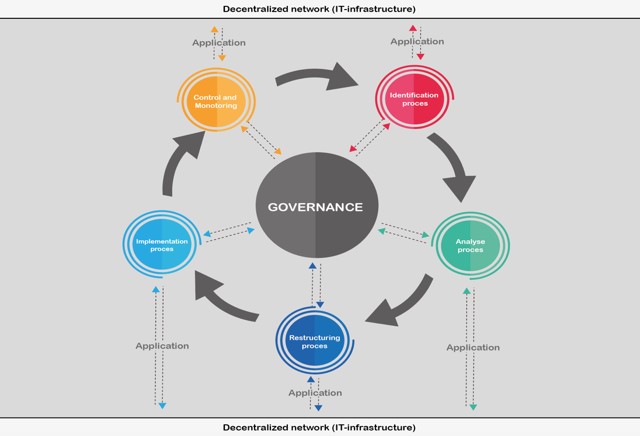Healthcare Governance Design in Blockchain
Abstract
As a technology, Blockchain will make an important contribution to organizing differently within profit, non-profit organizations and society. The aim of this reorganization is to reduce the pressure of regulation and work by digitally regulating the trust that is now often given by third parties. In addition, Blockchain goes over and through various processes, as a result of which third parties are no longer directly necessary due to the different organization of trust. What does organizing differently now mean for the use of coordination as a mechanism to steer organizations? This article, based on a thorough literature study will give an answer to this question. We looked at how coordination problems can be minimized by organizing it differently. Organizing differently here means no longer working from a central network but collaborating within a decentralized network with Blockchain as the technology. The interaction between the type of organization, the organizational policy, the processes, applications and infrastructure is essential in this respect, in which interoperability plays an important role. Blockchain ultimately contributes to reducing the response time of organizations, which in turn increases their adaptive capacity and therefore makes it possible to respond more quickly to changing market conditions, which are currently also occurring in the healthcare sector.
References
Beek van, D. (2018). De intelligente organisatie. In D. Beek van, De intelligente organisatie, continu verbeteren en innoveren met BI en Big Data (p. 353). Leusden: Passioned Publishers.
Berns,, S., de Jong,, N., Oosterkamp,, H., Stolk, R., Wesseling,, H., & Wieringa, W. (2019). Naar werkende governance op Blockchain in de zorg. Berenschot.
Bessems, P., & Bril, W. (2017). Blockchain Organiseren. Eindhoven: Mijnmanagementboek.
Delta, D. D. (2019). Retrieved from https://dutchblockchaincoalition.org/uploads/pdf/Dutch-Blockchain- Research-Agenda.pdf
Dumas, M. L. (2013). Introduction to Business Process Management. In M. L. Dumas, Fundamentals of Business Process Management (pp. 1-32). Heidelberg: Springer. https://doi.org/10.1007/978-3-642-33143-5_1
Forum, W. E. (2020, april 7). Retrieved from https://www.ledgerinsights.com/world-economic-forum-how- blockchain-could-help-with-covid-19-supply-chain-disruption/
Goossens, J., & Verslype, K. (2019). Blockchain en smart contracts. Tilburg: Tilburg University.
Hammelburg, R. L. (2019). Veranderende samenwerking in de zorg. Rotterdam: Springer Link.
Hewett, N., van Gogh, M., & Palinczki, L. (2020). Inclusive Deployment of Blockchain for Supply Chains: Part 6 - A Framework for Blockchain Interoperability. Geneva, Switzerland: World Economic Forum.
Janse, A., & Lin Lim, C. (2020). Basisboek Blockchain. In C. L. Janse, Basisboek Blockchain (pp. 154-166). Amsterdam: De boekdrukker.
Jewbali, L. (2019). Van gefundeerd vertrouwen naar gecodeerd vertrouwen? Een verkennend onderzoek naar het potentieel van Blockchaintechnologie bij Horizontaal Toezicht Zorg. Rotterdam: Horizontaal Toezicht Zorg.
Milani, F. G.-B. (2016). Blockchain and Business Process Improvement. BPTrends, 1-4.
Mintzberg, H. (1992). Structur in fives: Designing effective organizations. In H. Mintzberg, Structur in fives: Designing effective organizations. Upper Saddle River, NJ: Prentice Hall.
Nictiz. (2017). Blockchain in de zorg. Den Haag: Nictiz.
Olde Bijvank, S. (2020). Retrieved from http://www.house-of-control.nl/organisatiestructuren-mintzberg- configuratie-coordinatiemechansimen-organisatietypen.html
Onzetaal. (2017, 3 24). Retrieved from https://onzetaal.nl/taaladvies/willekeurig- onwillekeurig/
van Delden, P. (2009). Samenwerking in de publieke dienstverlening. In P. van Delden. Delft: Eburon.
Veuger, J. (2019), Sole Editor Blockchain Technology and Applications. Peer reviewed (262 p.) Nova Science Publishers Inc. New York USA. May 2019. ISBN 978-1-53615-288-3. Retrieved from https://novapublishers.com/shop/blockchain-technology-and-applications/
Book reviews. Retrieved from https://novapublishers.com/shop/blockchain-technology-and-applications/
Veuger, J. (2020). Blockchain Convergentie. In J. Veuger, Blockchain convergentie, een nieuwe economie en samenleving met Blockchain (p. 84). Deventer: Saxion University of Applied Sciences.
Zorgfraude, I. K. (2019). Jaarbeeld 2018. Utrecht: Informatie Knooppunt zorgfraude.
Zorgfraude, I. K. (2019). Rapport Signalen orgfraude 2018. Utrecht: Informatie Knooppunt Zorgfraude.


This work is licensed under a Creative Commons Attribution 4.0 International License.
Copyright for this article is retained by the author(s), with first publication rights granted to the journal.
This is an open-access article distributed under the terms and conditions of the Creative Commons Attribution license (http://creativecommons.org/licenses/by/4.0/).








1.png)














